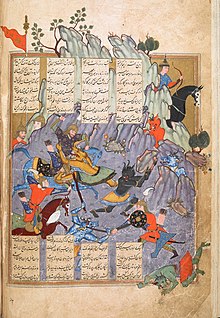Garshasp
In the Zoroastrian religious text of the Avesta, Kərəsāspa appears as the slayer of ferocious monsters, including the Gandarəβa and the Aži Sruvara.
As Kərəsāspa's fire began to crackle merrily, the heat from it caused the dragon to stir from its sleep and overturn the hero's kettle.
According to them, the Az ī Srūwar was a dragon with horns, with huge eyes and ears, and teeth upon which the men it had eaten could be seen impaled.
It was so long that Kərəsāspa ran along its back for half a day before he reached its head, struck it with his mace, and killed it.
It was also enormous, big enough to swallow twelve provinces in a single gulp, and so tall that when it stood up the deep sea reached only to its knee and its head was as high as the sun.
Certain of his deeds are recounted in the epic poem Shāhnāma, which preserves, in late form, many of the legends and stories of Greater Persia.
Garshāsp received his own poetic treatment at the hands of Asadi Tusi, who wrote a Garshāspnāma about this hero.
On one occasion when Zahhāk was traveling in Zābolestān, he saw Garshāsp and encourages him to slay a dragon that had emerged from the sea and settled on Mt.
After returning from India, Garshāsp woos a princess of Rum, restores his father Esret to his throne in Zābol after the king of Kābol defeats him, and builds the city of Sistān.




